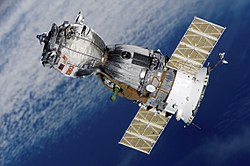
Summary
Soyuz TMA-7 (Russian: Союз ТМА-7) was a transport mission for portions of the International Space Station (ISS) Expedition 12 crew launched October 1, 2005. The flight delivered ISS Commander William McArthur and ISS Flight Engineer Valery Tokarev to the station to replace Expedition 11 crew members. Spaceflight Participant Gregory Olsen joined the TMA-7 crew for the ascent and docking with the ISS, spent approximately eight days aboard conducting experiments, then returned to Earth with the outgoing members of Expedition 11 aboard Soyuz TMA-6. McArthur and Tokarev were joined on their return trip to Earth by Flight Engineer Marcos Pontes who launched aboard Soyuz TMA-8 and spent approximately seven days aboard the ISS conducting experiments for the Brazilian Space Agency.
 | |
| Operator | Roskosmos |
|---|---|
| COSPAR ID | 2005-039A |
| SATCAT no. | 28877 |
| Mission duration | 189 days, 19 hours, 53 minutes |
| Orbits completed | 2,987 |
| Spacecraft properties | |
| Spacecraft type | Soyuz-TMA 11F732 |
| Manufacturer | RKK Energia |
| Launch mass | 7,200 kilograms (15,900 lb) |
| Crew | |
| Crew size | 3 |
| Members | Valery I. Tokarev William S. McArthur, Jr. |
| Launching | Gregory H. "Greg" Olsen |
| Landing | Marcos C. Pontes |
| Start of mission | |
| Launch date | October 1, 2005, 03:55:00 UTC |
| Rocket | Soyuz-FG |
| Launch site | Baikonur 1/5 |
| End of mission | |
| Landing date | April 8, 2006, 23:48:00 UTC |
| Orbital parameters | |
| Reference system | Geocentric |
| Regime | Low Earth |
| Perigee altitude | ~200 kilometres (120 mi) |
| Apogee altitude | ~252 kilometres (157 mi) |
| Inclination | ~51.7 degrees |
| Period | ~88.7 minutes |
| Docking with ISS | |
| Docking port | Pirs nadir |
| Docking date | 3 October 2005 05:27 UTC |
| Undocking date | 18 November 2005 08:46 UTC |
| Time docked | 46d 3h 19m |
| Docking with ISS (Relocation) | |
| Docking port | Zarya nadir |
| Docking date | 18 November 2005 09:05 UTC |
| Undocking date | 20 March 2006 06:49 UTC |
| Time docked | 121d 21h 44m |
| Docking with ISS (Relocation) | |
| Docking port | Zvezda aft |
| Docking date | 20 March 2006 07:11 UTC |
| Undocking date | 8 April 2006 20:28 UTC |
| Time docked | 19d 13h 17m |
 Soyuz programme (Crewed missions) | |

Crew edit
| Position | Launching crew | Landing crew |
|---|---|---|
| Commander | Valery Tokarev, RKA[1] Expedition 12 Second and last spaceflight | |
| Flight Engineer | William McArthur, NASA[1] Expedition 12 Fourth and last spaceflight | |
| Spaceflight Participant | Gregory Olsen, SA[1] Only spaceflight Space Tourist |
Marcos Pontes, AEB Only spaceflight |
Docking with ISS edit
- Docked to ISS: October 3, 2005, 05:27 UTC (to Pirs module)
- Undocked from ISS: November 18, 2005, 08:46 UTC (from Pirs module)
- Docked to ISS: November 18, 2005, 09:05 UTC (to nadir port of Zarya)
- Undocked from ISS: March 20, 2006, 06:49 UTC (from nadir port of Zarya)
- Docked to ISS: March 20, 2006, 07:11 UTC (to aft port of Zvezda)
- Undocked from ISS: April 8, 2006, 20:28 UTC (from aft port of Zvezda)
Mission highlights edit
28th crewed flight to ISS (Flight 11S).
Soyuz TMA-7 is a Soyuz spacecraft which was launched on October 1, 2005 by a Soyuz-FG rocket from Baikonur Cosmodrome.
The spacecraft carried two members of the Expedition 12 crew to the International Space Station, together with the space tourist Gregory Olsen. They replaced the Expedition 11 crew, Commander Sergei Krikalev and John Phillips.
The last member of the original Expedition 12 crew, Thomas Reiter finally launched in July 2006 on STS-121. Owing to shuttle mechanical and weather delays, he was forced to move to Expedition 13.
This was the last flight which is covered by the 1996 "balance" agreement that required the Russians to provide 11 Soyuz spacecraft to ferry joint U.S-Russian crews to and from the International Space Station. Further Soyuz flights needed a renegotiation between NASA and its Russian counterpart, and a modification of the Iran Nonproliferation Act of 2000.[2][3][4]
After re-entry, when the pilot parachute was deployed at a height of 10 km the main parachute took a while to open, which caused some concern among the crew and could have been fatal if the main parachute had taken longer to deploy.[2][3][4][5]
Replica edit
A company in Bauru is building a replica of the capsule that brought Marcos Pontes back to Earth, but they wrongly describe it as the Soyuz TMA-8.[6][7]
See also edit
- Pictures and narrative of launch.
References edit
- ^ a b c "OFFICIAL PRESS RELEASE about the return of the ISS-11 and VC-9 crews to the Earth". NPO Energia. October 11, 2005. Archived from the original on November 16, 2019. Retrieved December 17, 2008.
- ^ a b Mark Wade. "Soyuz TMA-7". Encyclopedia Astronautica. Archived from the original on November 6, 2016. Retrieved 2019-07-23.
- ^ a b Joachim Becker (2018-04-20). "Soyuz TMA-7". SPACEFACTS. Retrieved 2019-07-23.
- ^ a b Anatoly Zak (2012-05-05). "Soyuz TMA-7". RussianSpaceWeb. Retrieved 2019-07-23.
- ^ Pontes, Marcos (2011). "85". Missão Cumprida: A História completa da primeira missão espacial brasileira (in Brazilian Portuguese) (1 ed.). McHilliard. p. 361. ISBN 978-8564213012.
- ^ "Empresa produz réplica de cápsula que trouxe Marcos Pontes à Terra" (in Brazilian Portuguese). 2021-05-16. Archived from the original on 2021-05-17. Retrieved 2021-05-20.
- ^ "Aeródromo de Bauru terá réplica em tamanho original de cápsula espacial usada por Marcos Pontes" (in Brazilian Portuguese). 2021-05-12. Archived from the original on 2021-05-20. Retrieved 2021-05-20.


